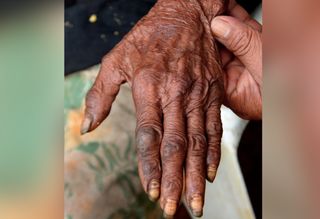Do Fleas Burrow Into Skin
How Sand Fleas Cause 'Extreme' Infections

Serious infections with sand fleas — parasites that couch into people's peel — are rare and oasis't been documented much over the last fifty years. But now, a new report describes v cases of "farthermost" sand flea infections in Colombia, showing that life-threatening illnesses with this parasite still occur.
The five patients each had hundreds to thousands of sand fleas embedded in their peel, and nigh of the patients were unable to move as a result of their condition, according to the written report, published today (Feb. 7) in the journal PLOS Neglected Tropical Diseases. One patient even needed a claret transfusion due to severe anemia — probable the result of the blood-sucking fleas.
Such farthermost cases often go unnoticed by health care providers, considering the patients with these infections alive in remote areas and lack access to health care, the study said.
"The truthful frequency of this devastating condition is probably underestimated," the written report authors wrote. [8 Atrocious Parasite Infections That Will Brand Your Skin Crawl]
Burrowing fleas
Sand fleas, or Tunga penetrans, are native to sure tropical areas, including parts of Due south America, the Caribbean, sub-Saharan Africa and Republic of madagascar. In humans, the insects cause a disease called tungiasis, in which the fleas burrow into the skin — normally in parts of the toes, the sole or the heel of the foot.
The fleas persistently suck the claret of their hosts and can increase their body size by a factor of 2,000 within weeks, according to the World Health Arrangement. Burrowed fleas can cause intense inflammation, pain and itching, and in severe cases, the burrowing can cause multiple lesions on the person'south feet, making it difficult to walk.
The fleas lay eggs through a hole in the skin, and the eggs fall to the ground where they hatch. After about iii weeks, the burrowed parasite dies and ceases causing symptoms. This means that, in theory, the illness is "self-limiting," or goes away on its own later on a period of time, the study authors said. Yet, in endemic and poverty-stricken areas, reinfection with the fleas is common and a person's "parasite load" can gradually increment over time, the authors said.
In the new written report, the researchers described five patients with tungiasis living in ethnic communities in a region of southeastern Colombia called the Vaupés section, which is part of the Amazon basin. The patients were seen over a menstruum of 12 weeks at a hospital in the city of Mitú, the simply hospital in the region.
Most of the patients were elderly (ages 69 to 94); lived in farthermost poverty; and had underlying conditions, such as osteoarthritis, that prevented them from moving around a lot.
The patients each had from 400 to 1,300 sand fleas embedded in their peel. The fleas were non only in the people's feet, but also in their knees, elbows, easily and fingers. All of the patients either had difficulty walking or were completely immobile when they were taken to the ER. Most had lost weight and muscle, weighing less than 80 lbs. (36 kilograms). All of the patients likewise had bacterial infections in their lesions.
Run a risk factors
A number of factors appeared to put the patients at risk for astringent sand flea infections. The people were elderly, which meant they oft had poor vision and weren't able to remove initial sand fleas with sharp instruments, every bit is ordinarily done in the area. Issues with mobility led them to stay in the same spot for hours at a time — often in a hammock shut to the ground — where they could have contact with soil and get reinfected with fleas. And due to extreme poverty, the patients' family members had difficulty caring for them.
Although the new study is small, with simply 5 cases, "it identified a pattern of characteristics which together make up one's mind [how] a cocky-limiting skin infection develops into a life-threatening illness," wrote the report authors, from the Vaupés Health Section.
The patients were treated with a medicine known as dimeticone, an oil that has been previously used to treat head lice. The report shows that this treatment is effective in killing hundreds of sand fleas, the authors said. After handling in the recent cases, the patients recovered apace and could attempt to walk once again.
"Dimeticone should exist made available to treat patients in an early stage of disease to avoid life-threatening sequels," the authors concluded.
- 27 Devastating Infectious Diseases
- 7 Strange Facts about the 'Heed-Control' Parasite Toxoplasma Gondii
- 10 Bizarre Diseases You Can Go Outdoors
Originally published on Alive Science .
Source: https://www.livescience.com/64716-sand-fleas-extreme-infections.html
Posted by: lowesarry1968.blogspot.com



0 Response to "Do Fleas Burrow Into Skin"
Post a Comment